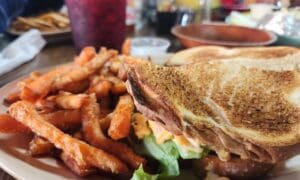In the Bible, the Apostle Paul wrote, “When I was a child, I thought as a child.”
When I was a child, though, I was far older than my actual age. Quietly, I stood back and watched the adults. I observed as stories played out. From quite an early time, I carried those stories to my bedroom, stood in front of the mirror and retold them. To no one. Just myself. I now see that I was practicing for the years to come.
In a weekly ritual, I’d return home from Sunday School then tell (quite dramatically) the morning’s lesson.
When I was five, I’d pull a piece of our brown leather Samsonite luggage from the closet, carefully pack my clothes, then play act that I was taking that suitcase to New York on “book business.”
How a child from the deep, rural South would know that New York was the center of book publishing still bewilders me. All I can say is: My destiny was born in me.
Distinctly, I remember once — in my child’s play — that I dropped the suitcase, read to an imaginary man, hugged him and exclaimed, “This is wonderful! You’re going to take my book!!”
Thirty years later, I played out that scene in New York City. The only difference was that my luggage was at the hotel and I was standing outside the Time-Life building, which housed Time-Warner books, when I hugged my agent after he grinned and said, “We’re going to sell this book.” A beat. “For a lot of money.”
We did.
That book, “What Southern Women Know (That Every Woman Should),” was an immediate bestseller and, 20 years later, is still a noted title. I made my name as an author and columnist by writing nonfiction.
Several years ago, however, I wrote a novel, inspired by a wonderful, personal experience infused with lovely, generous Southerners and, it too, was successful: a bestseller, a Reader’s Digest Condensed book, and a television movie.
Here’s what I’ve learned about fiction: Every author’s first novel is seeded heavily with personal experience. It’s the novels that come later where authors have to start making up stuff. Famed Southern author and colorful character, Pat Conroy, readily admitted that he used his family in his much-loved novels.
“The greatest gift an author can have is to be born into a dysfunctional family,” He laughed heartily.
If you want to write a series of mysteries, romances, beach or family books, there is a formula. Read the authors you love best and figure out the formula. My husband, Tink, as a television writer, can tell you what happens in each act of an episode, when the crisis occurs, and when it is solved.
The life that surrounds me is filled with entertaining stories, eye-opening experiences, and colorful characters. That’s why it’s easy to find a story for this column regularly.
Awhile back, I and my dachshund, Dew Drop, were down on St. Simons, off the Georgia coast, while Tink was home working on a television series. It was February, a time when the island has few visitors and the sea and sky seems to be particularly cloudy and restless.
As Dew Drop and I walked the empty beach one day, a line came roaring into my head: “Chatham Balsam Colquitt IV was beside himself with joy.”
I didn’t know who he was, or what the story was, but I sensed a novel’s beginning. I raced to the condo and begin typing furiously. The truth about a novel is that it owns you — but you own a nonfiction book.
Obediently, I followed and a book was born: “St. Simons Island: A Stella Bankwell Mystery,” published August 8 by Mercer University Press. It is the first in a series that will feature Stella solving mysteries on different Georgia islands.
I will now follow Stella to Sapelo where I must depend on her to tell me the story.
She’s keeping it a mystery right now.
[Ronda Rich is the best-selling author of “St. Simons Island: A Stella Bankwell Mystery.” Visit www.rondarich.com to sign up for her free weekly newsletter.]













Leave a Comment
You must be logged in to post a comment.